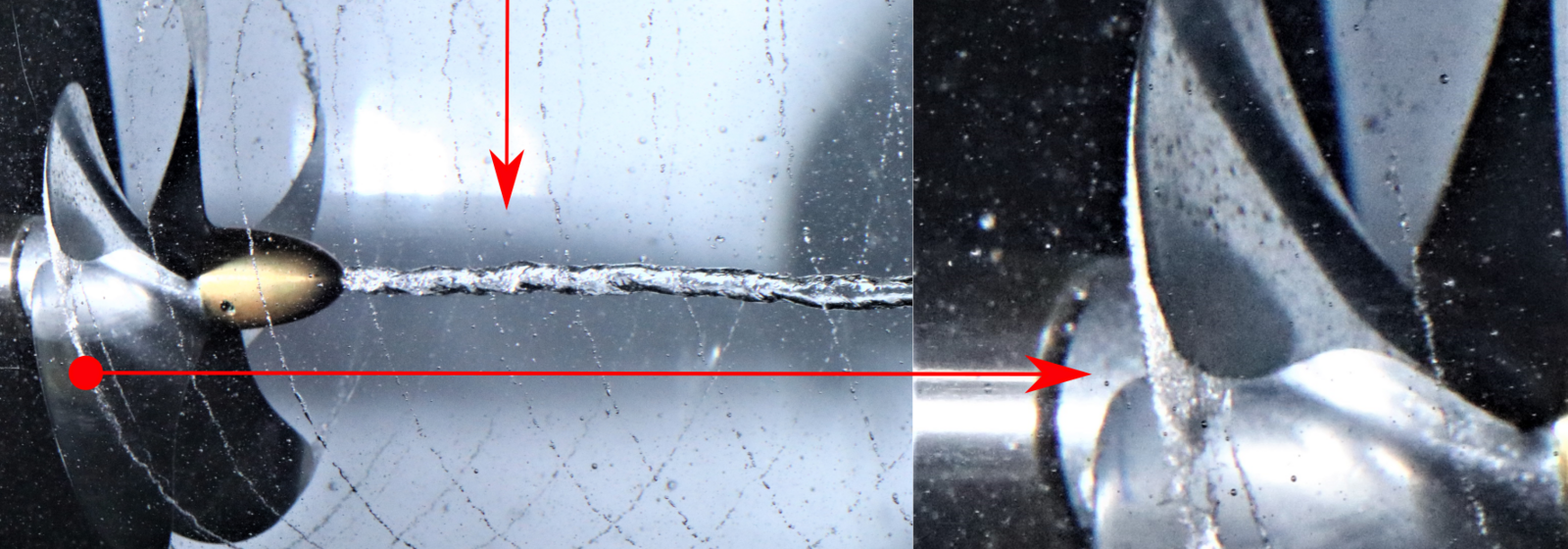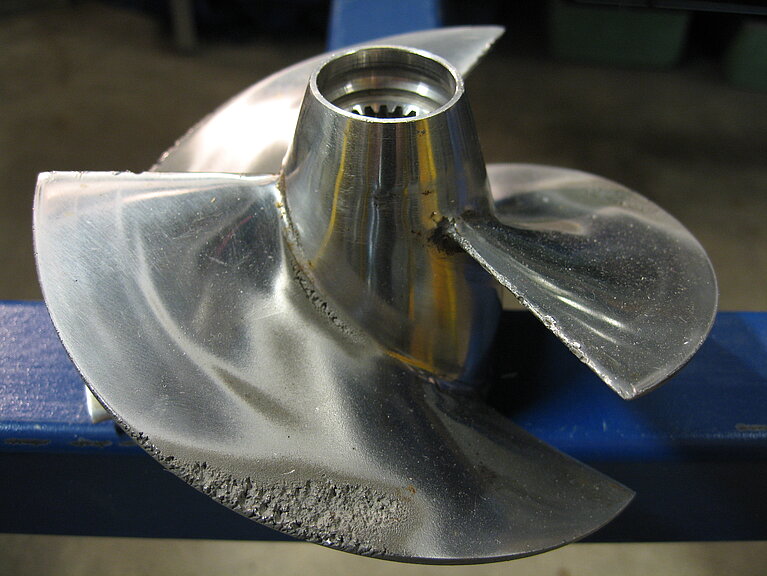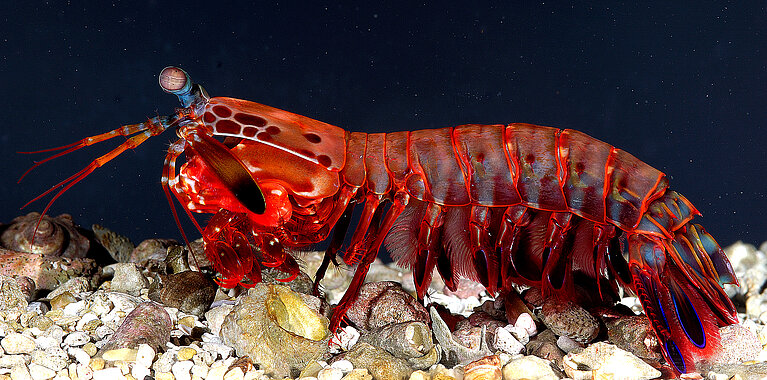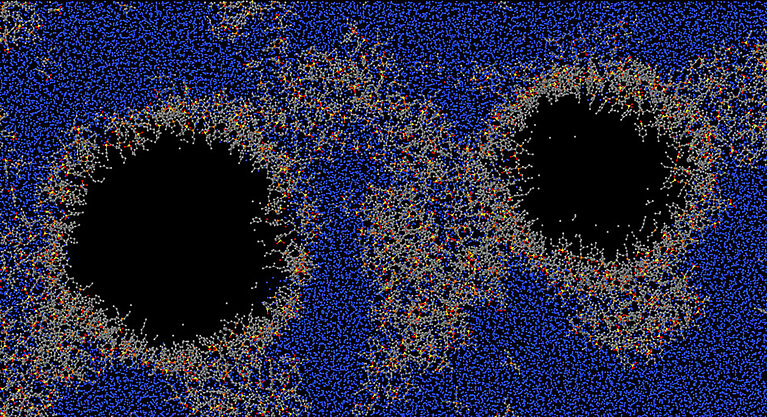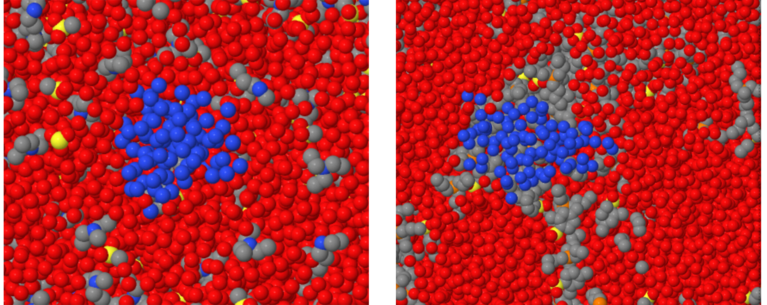December 21, 2023 - by Santina Russo
Imagine tiny air bubbles only a fraction of a millimetre in size. They cannot possibly do any harm, right? Wrong. They can even damage large and strong metal objects such as ships’ propellers, if the right — or rather wrong — physics occur.
The process causing this damage is called cavitation. It refers to the formation and subsequent collapse of vapour-filled bubbles, a process that can occur on objects moving rapidly in water and other liquids, such as ship propellers or turbines in hydroelectric power plants. Cavitation bubbles differ from conventional ones that form when gas is introduced into a liquid: A cavitation bubble is formed instead through pressure differences — more specifically, by negative pressure that essentially tears the liquid apart, leading to the formation of vapour-filled cavities. As these bubbles subsequently implode under the external pressure, they release large amounts of energy, which is responsible for the severe corrosion of propellers, turbines, gear pumps, and similar devices.
At the same time, this phenomenon of nucleation and further evolution of bubbles in a liquid could also be useful — providing that it can be controlled. “That’s why we want to better understand the processes involved,” says Raffaela Cabriolu, an associate professor at the Department of Physics at the Norwegian University of Science and Technology (NTNU). Together with her co-workers, she investigated the nucleation, growth, and collapse of such bubbles using molecular dynamics simulations carried out on CSCS’s supercomputer “Piz Daint”.
Bubbles to open the blood-brain barrier
One possible beneficial application of such cavitation bubbles lies in their assistance in overcoming the blood-brain barrier to bring medical drugs into brain tissue — such as drugs that fight cancer or neurodegenerative diseases like Alzheimer’s and Parkinson’s. The blood-brain barrier is a natural safety feature that allows passage to the brain only for certain nutrients and prevents access to everything else. Consequently, it is notoriously difficult to overcome for drug molecules. “Cavitation bubbles could help with this,” says Cabriolu. Some research groups and companies are already working on an approach, in which cavitation bubbles are controlled by ultrasound to create mechanical forces on the blood capillary walls. These forces temporarily open the blood-brain barrier for drugs to move through.
This way of mediating cavitation bubbles by acoustic waves has a model in nature: the snapping shrimps and some species of mantis shrimp. These crustaceans can smash their prey with strikes from their claws so powerful that the associated sound waves create cavitation bubbles.
Similarly, the formation and collapse of such bubbles can be mediated by ultrasound. Its propagating sound waves create areas of higher and lower pressure. Low pressure will lead to the formation of cavitation bubbles, while higher pressure will result in their collapse. “The goal is to find an equilibrium and make the bubbles resistant enough to be transported to the right location in the body,” Cabriolu explains.
Exploiting the subtle energy burst
Also, the powerful but localized and therefore subtle release of energy as the bubbles implode can be used for a variety of applications: For example, for generating nickel and platinum nanoparticles in a more cost-effective way than to date, which are used as chemical catalysts for essential reactions in the food and cosmetic industry. Still other possible applications lie in microelectronics and in creating sustainable fuels.
To gain more knowledge about ways to modulate the bubbles, Cabriolu and her team performed a set of high-performance molecular dynamics simulations. They used the open-source parallelized software suite GROMACS as well as self-developed codes for the post-processing, for example, to analyse the bubbles’ dimensions, their lifetime, and the released energy bursts.
In contrast to previous simulations from other scientists, the team included two different solvents in this one to investigate their effect on the bubbles: The first, tetraethylammonium mesylate (TEA), is hydrophilic and therefore highly soluble in water; the second, 2,4-dimethyl benzenesulfonate (DMBS), is amphiphilic, meaning it is built by a hydrophilic tail and a hydrophobic water-repellent head. Therefore, the simulations not only provided Cabriolu and her team with an atomistic description of the formation and collapse of the bubbles, but also of the behaviour and impact of the solvent molecules.
Particularly interesting was the effect of the amphiphilic solvent DMBS: The molecules’ hydrophilic tails interacted with the water molecules; the hydrophobic heads connected to the bubbles. As such, the simulations revealed that the DMBS molecules fully surrounded the bubbles, offering protection as the pressure in the bubbles’ environment was increased. “While they imploded as expected in the presence of the hydrophilic solvent TEA, the bubbles stayed strong and stable in DMBS,” recounts Cabriolu. “With this, we have demonstrated that we can control the stability and the lifetime of the bubbles via the composition of the solvent.”
Using a clue discovered by chance
To obtain such accurate simulations, a crucial role is played by the simulation conditions, which are a combination of system size, preparation protocol, pressure, temperature, and other mathematical parameters whose choice greatly relies on experience. Another difficulty when studying the interaction between molecules lies in parametrising the so-called interatomic force fields. These mathematical models describe the interaction between molecules and provide the physical basis of molecular dynamics computations. “The force field has to describe your system well for the results to be accurate and make sense,” explains Cabriolu. Interestingly, the physicist found the correct setup for the bubble system by pure luck — while looking for something different.
At the time, Cabriolu was investigating Metal-Organic-Frameworks (MOFs). These are crystalline compounds that consist of metal clusters and organic linkers. Many MOFs are porous, and they are investigated for their capability to store gases such as CO2. “We were working to find the force fields of the MOFs to reproduce their behaviour in water, and in the process, created water bubbles by mistake,” recounts Cabriolu. This chance event led Cabriolu to the correct force fields for investigating the bubbles.
“Incidentally, the cavitation study was possible thanks to the flexibility of the CSCS computing resources, which allowed me the freedom to explore the bubbles instead of the actual planned project,” she added. “This is highly appreciated.” And successful: Cabriolu’s recent paper on the bubble’s dynamics in the Journal of Physical Chemistry B is already having an impact in the community. It was written together with Bruno Pollet at the University of Quebec in Trois-Rivières, Canada, and Pietro Ballone at University College in Dublin, Ireland, who have introduced Cabriolu to the field of bubbles. On a side note: The results of the original MOF project, are currently being prepared for publication as well.
From nanoscale to micro-bubbles
In their future work, Cabriolu and her co-workers aim to analyse the energy burst generated by the bubbles’ implosion in more detail and investigate how to best exploit it. “An advantage of this subtle energy source is that it is very clean,” says Cabriolu. “Finding a way to use it would mean a step forward for many fields.” To do this, they will increase the size of the simulated bubbles from the current nanometre scale to micrometres as well as enlarge their simulation samples.
Image above: Cavitation occurring in a propeller: The formation and subsequent collapse of minute water bubbles (visible in the image on the right) can inflict serious damage on the material. (Image: Wikimedia Commons, Rafael Golf)
Reference:
- R. Cabriolu, B.G. Pollet, and P. Ballone: Effect of Organic Ions on The Formation and Collapse of Nanometric Bubbles in Ionic Liquid/Water Solutions: A Molecular Dynamics Study, J. Phys. Chem. B (2023), DOI: https://doi.org/10.1021/acs.jpcb.2c07950
This article may be used on other media and online portals provided the copyright conditions are observed.
